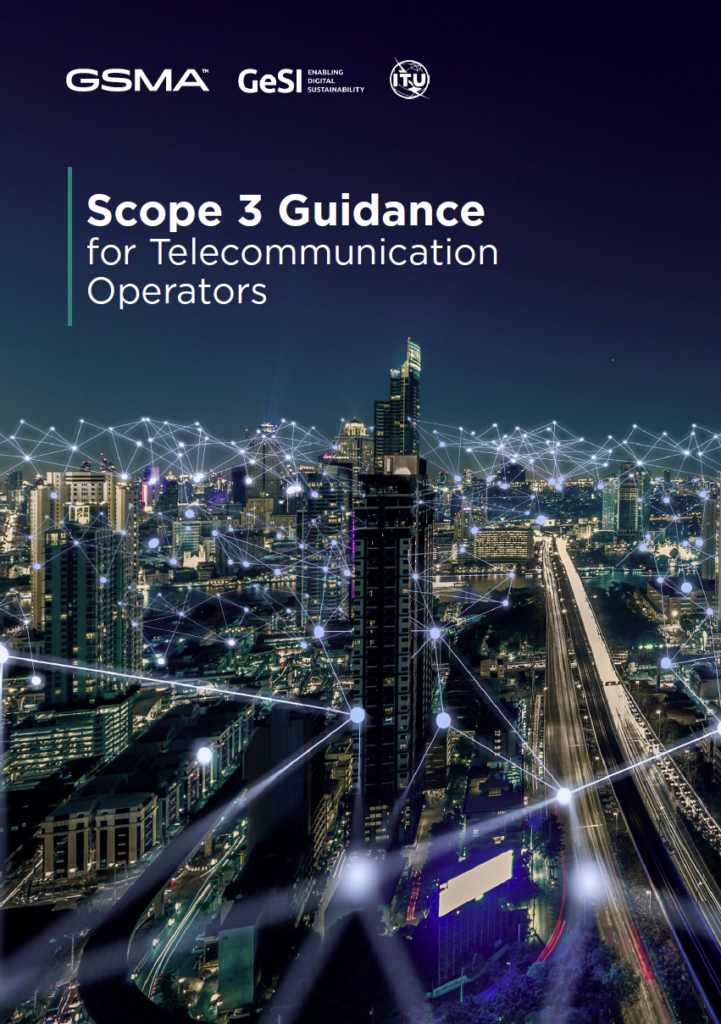In today’s rapidly heating world, addressing climate change has become a top priority for industries across the globe. The big question: how do you transform a whole industry? First, you need a vision of what to transform into. This could be the vision of reducing an industry’s climate impacts to net zero. Second, you need a deadline for when to achieve it. The long-term vision could be 2050, but that’s far away, and perhaps difficult to generate immediate action. A nearer interim target is needed, say by 2030. Limiting global heating to 1.5°C means halving carbon emissions by 2030 versus 2020.
In this blog post, we explore how the mobile sector is working together to achieve a net zero transformation, focussing on one particular challenge: assessing indirect carbon emissions, also known as ‘Scope 3’ emissions. We’ll delve into this challenge and the collaborative efforts being made by companies, NGOs and the UN to align on measurement, paving the way for a greener and more responsible industry.
Responsibility and Alignment
To ensure meaningful progress and accountability, high-profile companies can make public commitments. But these commitments need to be aligned if an industry is to achieve its long-term vision. And alignment is needed not only for their direct impacts but also for indirect impacts from both up-and downstream operations such as Scope 3 emissions. In the absence of specific legislation, this voluntary alignment is essential. Incredibly, this is the situation happening in industries around the world and being championed across the mobile industry.
A big vision of being net zero by 2050 was set in 2019, and since then mobile network operators have been committing and aligning their targets to this long-term vision by targeting halving emissions by 2030. Globally 64 operators are aligned, covering more than 60% of network operator revenue. And not just their direct emissions, but also their indirect emissions as well.
Scope 3 emissions pose a significant challenge to the mobile sector as they are by far the largest. It’s estimated that they are between 3 and 10 times larger than a mobile network operator’s direct emissions. These emissions are difficult to assess: there are 15 different categories of Scope 3 emissions.
The GSMA has been running a Climate Action Taskforce with its members since 2019. A project group of the Taskforce identified Scope 3 emissions as a challenge for the industry and decided to compare methods and outputs of assessing Scope 3 emissions between operators.
A Major Challenge

It became clear that operators were assessing Scope 3 emissions using different boundaries, methodologies, and databases of emissions factors. This led to significantly divergent Scope 3 emissions figures for relatively similar businesses and gave the impetus to work together to agree on a common approach which would culminate in the Scope 3 Guidance for Telecommunications Operators.
Collaboration and Guidance
We discovered that GeSI and the ITU were also interested in aligning on Scope 3 assessment for the ICT sector and so we united in a steering committee to work together to create the guidance. The first challenge was how to approach the methodology as Scope 3 covers a large number of Categories, each of which would need to be addressed.
By this point, the Project Group had grown to include representatives from more than 50 organisations so there was a large pool of motivated individuals who were willing to join forces and create something for the whole industry. Project members were invited to step forward and lead a category.
Simplicity and Continuous Improvement
There was a great response and over the next few months, the category leads worked in small groups with project members to develop guidance for each of the main categories. The steering committee provided guiding principles on how each category should be structured and reviewed the content to ensure consistency.
One of the principles was that for more complex categories such as 1 and 2, we wanted to provide guidance that would apply to all, from those who had never assessed Scope 3 emissions, to those who had been working to estimate them for several years. This meant giving several options aligned with science-based principles, as well as hot-spotting, to focus time and effort on the largest emission sources.
Another principle explained that a perfect measurement straight away wasn’t needed, and instead to expect that accuracy will improve over time. This goes in hand with the principle to use the simplest approach that will give the required accuracy and best support the reduction goal. These and other principles formed part of the introduction to the guidance and included advice that assessment is a means to reduction, rather than an end in itself.
Engagement with Supply Chain
Whilst there has been great collaboration amongst telecommunication operators and others in the ICT sector, there is still much to be done with the supply chain. In general, engagement with suppliers is needed to explain the data requirements that their downstream customers need. This is something the steering committee would like to prompt with a dedicated workshop with suppliers planned for September.
Beyond data collection, further alignment is needed with suppliers on how the data they provide has been calculated. Data on product carbon emissions are calculated using life cycle assessment (LCA), however, there are variations in boundaries, methodologies, and emission factors for LCAs. This means two similar products can end up reporting significantly different carbon footprints. More harmonisation of LCA approaches is needed to create comparable figures.
What more do we need to see happen across the industry? We would benefit from a system that can collect and share primary data from comparable LCAs. The CDP questionnaire and reporting system can be an excellent place to start and is undergoing upgrades, which will improve the data that’s accessible. This information is becoming increasingly important for regulators, policymakers and companies, especially with the development of regulations such as carbon border taxes.
Mobile network operators’ commitment to reducing climate impacts and achieving net zero emissions by 2050 is commendable. Through collaborative efforts, the industry has already made significant strides in aligning on Scope 3 assessment. With continued dedication and shared vision, the mobile sector can serve as a shining example for other industries, showing that transformation towards a sustainable future is not only possible but essential.
I would like to thank the Steering Committee of Jean-Manuel Canet at Orange, Alex Campbell at TDC NET, Simon Antony at Telstra, Chris Tuppen at Advancing Sustainability, John Pflueger at Dell, and Pernilla Bergmark at Ericsson for their invaluable leadership and insights, and Varnika Srivastava and Reyna Ubeda for their project management.
